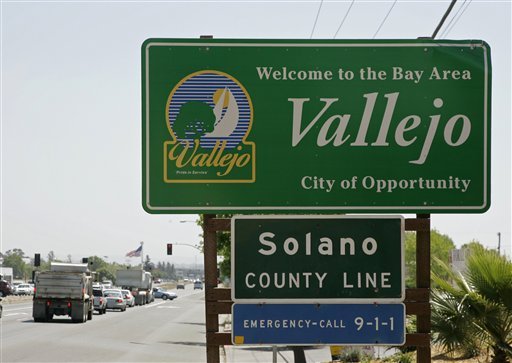The city of Vallejo filed for bankruptcy protection Friday to
deal with a ballooning budget deficit caused by soaring employee
costs and declining tax revenue.
A sign is seen in Vallejo, Calif., on Tuesday, May 6, 2008. The
city of Vallejo filed for bankruptcy protection Friday, May 23,
2008, to deal with a ballooning budget deficit caused by soaring
employee costs and declining tax revenue. The San Francisco Bay
area suburb of about 120,000 residents became the largest
California city to seek bankruptcy protection.
The city of Vallejo filed for bankruptcy protection Friday to deal with a ballooning budget deficit caused by soaring employee costs and declining tax revenue.
The San Francisco Bay area suburb of about 120,000 residents became the largest California city to declare bankruptcy, which will protect the city from its creditors while it develops a plan to return to fiscal health.
Mayor Osby Davis said the city’s attorneys filed papers seeking Chapter 9 bankruptcy protection in federal court in Sacramento.
“We’ve exhausted all avenues at this point, and this is all we had left,” Davis said. “I had hoped to avoid it all the way up until yesterday. It’s something we can’t avoid. It just doesn’t work. We can’t pay our bills.”
Vallejo will ask the judge to set a June 9 deadline for creditors to challenge the filing, said Marc Levinson, the city’s bankruptcy attorney.
The police and firefighter unions plan to file a legal challenge, arguing that the city’s finances aren’t as dire as officials claim and there are other ways to fix the budget deficit, said Mat Mustard, vice president of the Vallejo Police Officers Association.
“Filing for bankruptcy is and was unnecessary,” Mustard said. “Yes, I believe they have a financial crisis, but I think they’re turning their crisis into a catastrophe by going into bankruptcy.”
The seven-member City Council voted unanimously to authorize the city manager to file for bankruptcy on May 6 after months of failed negotiations with the police and firefighters unions.
After that vote, city officials and union representatives continued to meet in hopes of reaching a last-minute deal to stave off bankruptcy, but the two sides couldn’t reach an agreement.
Vallejo, a mostly working-class city about 30 miles northeast of San Francisco, faces a $16 million budget deficit in its fiscal year starting July 1.
The real estate crisis and economic downturn have caused a sharp decline in revenue from sales tax, property tax and development fees. Solano County, where Vallejo is located, has been hit especially hard by the mortgage crisis and has one of the nation’s highest foreclosure rates.
Many officials and residents blame Vallejo’s chronic financial problems on labor contracts that they say provide overly generous pay and benefits to the city’s police officers and firefighters, which make up about three-quarters of the city’s general fund.
The unions say compensation for Vallejo’s public safety employees is in line with that of other Bay Area cities, and blame the fiscal crisis on government mismanagement and poor decisions by previous city councils.
Other cities around the country could find themselves in the same position as Vallejo because they’re also struggling with skyrocketing employee expenses and falling revenues, experts say.
“If the economy doesn’t turn, you’re going to see other cities in the same spot,” said Marcia Fritz, vice president of the California Foundation for Fiscal Responsibility. “You’re seeing a lot of cities and counties where reserves are being drawn down to pay for benefits.”
In addition to being the largest California city to declare bankruptcy, Vallejo also is the first to do so because its revenues cannot cover expenses, experts say.
Orange County filed for bankruptcy in 1994 after it lost money in a series of bad investments; the Southern California town of Desert Hot Springs declared bankruptcy in 2001 after losing a lawsuit.
Some officials worry that bankruptcy could damage the city’s reputation and ability to attract residents and businesses, but others say the city could eventually emerge stronger and more financially secure.
“The mismanagement of the city for so long has tarnished our reputation, not bankruptcy,” said Councilwoman Stephanie Gomes. “Bankruptcy gives us the opportunity to fix that mismanagement and put a long-term plan in place to ensure true growth and recovery.”













